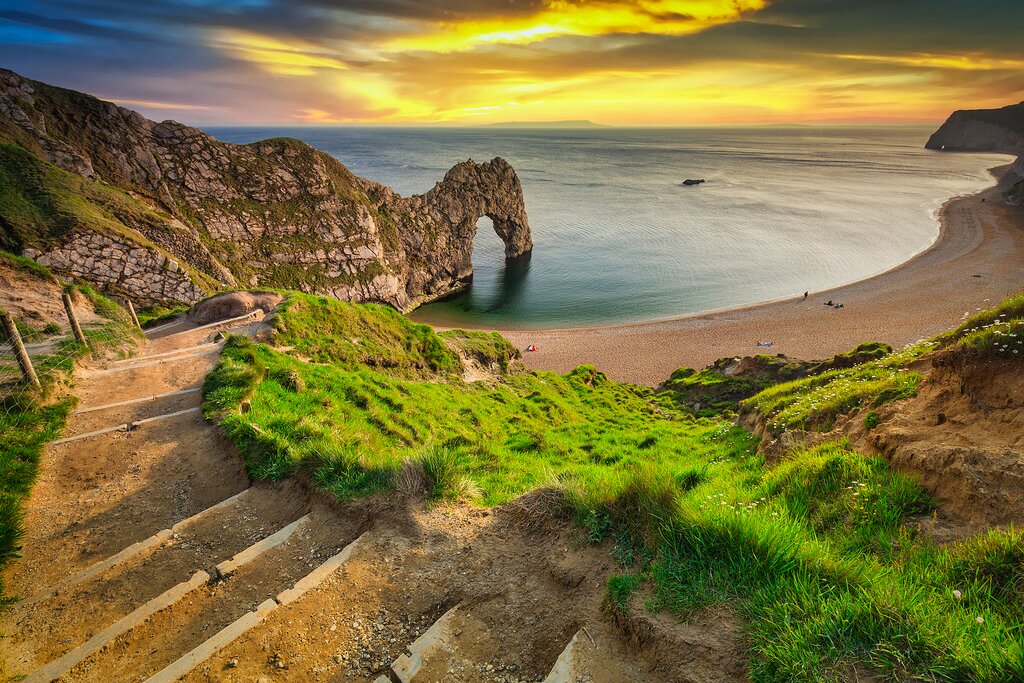
September is one of the best (and driest) months to travel in England. Summer is still in session, yet the peak crowds are starting to dissipate for more peace and quiet. Meanwhile, those who like to nosh can flock to several foodie events around the country—like a seafood fest in Dorset, which pairs nicely with the area’s stunning coastal trails.
Weather
As the calendar turns to September, England experiences a shift in seasons, a transition from the height of summer towards the embrace of autumn. However, the weather during this month often remains surprisingly pleasant, offering a delightful window for outdoor activities, particularly along the stunning beaches and within the numerous verdant parks. This holds especially true during the first half of September, when the days are still relatively long, granting more than 13 hours of daylight for exploration and enjoyment. The lingering warmth of the summer sun creates an inviting atmosphere for visitors and locals alike.
Regarding temperatures, the nation’s bustling capital, London, typically sees daily high temperatures averaging around 68°F (20°C). The evenings bring a gentle coolness, with lows averaging around 55°F (13°C). This creates a comfortable climate ideal for both daytime adventures and relaxing evenings. As you venture further north, to cities such as Newcastle and Manchester, it’s important to note that temperatures tend to be a few degrees cooler. This difference is primarily due to their geographical location and increased exposure to the elements. Similarly, coastal regions, influenced by their proximity to the vast Atlantic Ocean or the chilly North Sea, often experience slightly cooler temperatures and brisker breezes.
Rainfall in September is historically less frequent and intense compared to the approaching fall and winter months. On average, the country experiences approximately 2.7 inches (7 cm) of moisture during this period. However, it’s crucial to remember that the island of Great Britain is renowned for its unpredictable and often fickle weather patterns. Therefore, it is essential to pack a versatile wardrobe that includes light clothing suitable for milder days, as well as warm, waterproof layers capable of providing protection against sudden and unexpected changes in the forecast. Should rainfall occur, it is generally short-lived, typically lasting only a few hours rather than persisting throughout the entire day. This makes it easier to plan outdoor activities with the knowledge that any showers are likely to be temporary.
Crowds & Costs
September signals the end of the peak tourist season in England. The large crowds and elevated prices associated with flights, accommodations, car rentals, and various activities gradually begin to subside. This provides a welcome relief from the bustling and often expensive atmosphere of the summer months. The majority of families who traveled to popular English destinations during August have now returned home, resuming their regular autumn routines of school and work. This leaves locals, along with savvy travelers who are aware of this seasonal shift, with a greater sense of space and opportunity to enjoy the last remaining weeks of summer.
Despite the reduced crowds and relatively lower prices, September still falls within the shoulder season. Therefore, it remains prudent to consider booking tickets and making reservations as far in advance as possible. This proactive approach ensures that you secure the best available prices and guarantee availability for your desired accommodations, transportation, and activities. Planning ahead can significantly enhance your overall travel experience, allowing you to fully enjoy all that England has to offer without the stress of last-minute bookings or limited options.
Where to Go
With the summer tourist throngs starting to diminish, September presents a remarkable opportunity to explore the sprawling capital city of London. This iconic metropolis is recognized as one of the most celebrated cities in the world, and rightfully so. When planning a trip to London, it’s important to consider that the city is divided into 32 distinct boroughs, each offering a unique character and a diverse range of attractions. There is an abundance of sights and experiences to fill a week or more, but even with only a few days, visitors can pack an impressive amount of activity into their itinerary. For those visiting London for the first time, it is generally recommended to stay close to the city center. This provides easy walking access to numerous historic and trendy neighborhoods, such as Southwark. In Southwark, you can enjoy iconic landmarks such as the London Eye, offering panoramic views of the city, and cross the architecturally stunning Millennium Bridge, which connects the renowned Tate Modern art gallery with the magnificent St. Paul’s Cathedral.
If you choose to establish London as your central base, a variety of convenient day trip options are readily available by train. Consider visiting historic university towns like Oxford and Cambridge, which will be welcoming students back to campus at this time of year, creating a vibrant atmosphere. Alternatively, you could rent a car and embark on a scenic road trip through the picturesque countryside. September is an exceptionally lovely time to explore the Cotswolds, a captivating hilly region encompassing six counties. Here, you’ll discover quintessential English villages, charming farmer’s markets overflowing with late-summer harvests, and stunning natural beauty. You could also embark on a drive to one of the ten national parks, such as the breathtaking Lake District National Park, a romantic area situated near Scotland that has long served as a source of inspiration for artists and writers.
The beaches along the south coast will be experiencing a period of gradual quietness, creating a serene and peaceful atmosphere. This makes September an ideal month for savoring the last remnants of summer. If you’re interested in a trip that blends relaxation with invigorating physical activity, consider a multi-day hike along the renowned UNESCO-listed Jurassic Coast. This remarkable coastal trail offers overnight stops at picturesque harbor towns that are celebrated for their fresh seafood. The 95-mile (153 km) stretch of the English Channel earns its apt name from the fascinating array of rocks it contains, representing various prehistoric periods. Moreover, the area boasts rare flora and an abundance of captivating birdlife.
What to Do
Beyond the famed Jurassic Coast, England offers a diverse selection of coastal trails suitable for both day hikes and longer multi-day treks. The longest coastal path in the country is the extensive 630-mile (1,014 km) South Way Coast Path, which traverses the entire Cornish Peninsula. This remarkable trail winds its way past rugged cliffs, secluded coves, rolling dunes, and a wealth of historical attractions, including the legendary Tintagel Castle, a medieval fortress now enhanced with a pedestrian bridge for improved access. This area is steeped in Arthurian legend, adding an extra layer of mystique to your visit.
Surfing is another favored pastime in Cornwall, and numerous locations, such as Gwithian Beach, provide rentals and instruction to cater to all skill levels. Whether you are an experienced surfer or a complete beginner, Cornwall has something to offer. Summer waves are typically gentler and more forgiving, making them ideal for learning the basics. Conversely, winter waves tend to be larger and more powerful, better suited for experienced surfers seeking a challenge. The south coast, in general, provides a multitude of beaches renowned for watersports of all kinds. For instance, near Exmouth, you’ll find a regional hub for water-based activities such as kayaking, windsurfing, and kite surfing.
Inland, England offers equally compelling options for outdoor enthusiasts. The Cotswold Way, a 102-mile long-distance route, connects to a network of trails designed for hiking, biking, and horseback riding. While exploring this scenic region, be sure to visit some of the area’s famous English gardens, such as the 10-acre Hidcote Gardens, which are part of a historic manor home. You could easily dedicate an entire day to touring Blenheim Palace, the UNESCO-listed birthplace of Winston Churchill, complete with 2,000 acres of stunning grounds to explore. This grand estate offers a glimpse into English history and culture.
Consider the wealth of cultural opportunities that occur outdoors. If your travel plans bring you to the medieval city of York for their September food festival, be sure to take a walk along the city’s well-preserved fortified walls. This leisurely stroll can take a couple of hours, especially if you take the time to read the informational plaques along the way. Harry Potter fans, for their part, can embark on a tour of the Shambles, York’s famous medieval street said to have been the inspiration for the Diagon Alley featured in the Harry Potter series. A multitude of private and group tour options are available throughout the country. These tours are an excellent way to get oriented, whether you want to take a pub tour in London or learn about Shakespeare’s formative years in Stratford-Upon-Avon.
Events in September
Totally Thames, London. This month-long festival along the south bank of the River Thames provides a full program of arts, cultural activities, active tours, and environmental initiatives, appealing to a broad range of interests.
Blackpool Illuminations, Blackpool. This annual outdoor light festival, which is free to attend, takes place in the seaside resort town of Blackpool, attracting visitors of all ages. The festival commences in September and continues through January, providing a spectacular display of lights and artistry.
Heritage Open Days, nationwide. During this week-long event, organized by volunteers, look for free access to hundreds of historical and cultural sites located throughout England, including many hidden gems that are not typically open to the public.
Horn Dance, Abbots Bromley. This pagan-inspired dance event represents a beloved English festival steeped in medieval costumes and customs, offering a unique cultural experience.
Jane Austen Festival, Bath. Literary enthusiasts can journey to the city of Bath for a 10-day festival celebrating the life and works of Jane Austen, one of England’s most celebrated authors.
Ludlow Food Festival, Ludlow. This annual festival at the historic Ludlow Castle draws nearly 200 local purveyors and exhibitors, providing visitors with the opportunity to sample a variety of tasty treats and local ales.
York Food and Drink Festival, York. This popular food festival serves as a highlight of the Yorkshire calendar, featuring local produce, tastings, cooking demonstrations, as well as pop-up restaurants and bars.
SEAFEST Seafood Festival, Dorset. Each September, the Dorset coast hosts England’s largest festival of seafood for two days, offering foodies the chance to indulge in the local catch, including hand-dived scallops, crab, cockles, and prawns.
B-749

